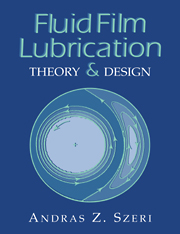Book contents
- Frontmatter
- Contents
- Preface
- 1 Introduction
- 2 Basic Equations
- 3 Thick-Film Lubrication
- 4 Dynamic Properties of Lubricant Films
- 5 Effects of Fluid Inertia
- 6 Flow Stability and Transition
- 7 Turbulence
- 8 Elastohydrodynamic Lubrication
- 9 Thermal Effects
- 10 Lubrication with Non-Newtonian Fluids
- 11 Gas Lubrication
- Index
3 - Thick-Film Lubrication
Published online by Cambridge University Press: 12 January 2010
- Frontmatter
- Contents
- Preface
- 1 Introduction
- 2 Basic Equations
- 3 Thick-Film Lubrication
- 4 Dynamic Properties of Lubricant Films
- 5 Effects of Fluid Inertia
- 6 Flow Stability and Transition
- 7 Turbulence
- 8 Elastohydrodynamic Lubrication
- 9 Thermal Effects
- 10 Lubrication with Non-Newtonian Fluids
- 11 Gas Lubrication
- Index
Summary
Fluid film lubrication naturally divides into two categories. Thin-film lubrication is usually met with in counter-formal contacts, principally in rolling bearings and in gears. The thickness of the film in these contacts is of order of 1µxm or less, and the conditions are such that the pressure dependence of viscosity and the elastic deformation of the bounding surfaces must both be taken into account.
Thick-film lubrication is encountered in externally pressurized bearings, also called hydrostatic bearings, and in self-acting bearings, called hydrodynamic bearings. Of the latter, there are two kinds: journal bearings and thrust bearings. The film thickness in these conformal-contact bearings is at least an order of magnitude larger than in counter-formal bearings. In consequence, the prevailing pressures are orders of magnitude smaller, so that neither the pressure dependence of viscosity nor the elastic deformation of the surfaces plays an important roles. If, in addition, the lubricant is linearly viscous and the reduced Reynolds number is small, the classical Reynolds theory, as derived in the previous chapter, will apply.
This chapter discusses isothermal processes only. It should be realized, however, that bearings never operate under truly isothermal conditions, and under near isothermal conditions only in exceptional cases. Viscous dissipation and consequent heating of the lubricant are always present, and the change in viscosity must be accounted for when analyzing thick-film lubrication problems. In restricted cases, where design and operating conditions are such as to suggest “uniform” temperature rise of the lubricant, the “effective viscosity” approach of Chapter 9 might be employed.
- Type
- Chapter
- Information
- Fluid Film LubricationTheory and Design, pp. 81 - 131Publisher: Cambridge University PressPrint publication year: 1998
- 1
- Cited by



